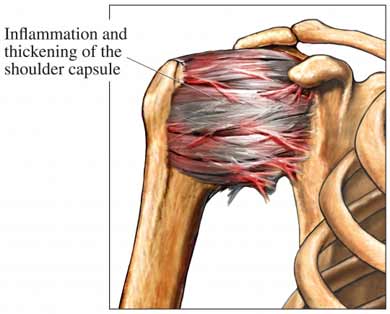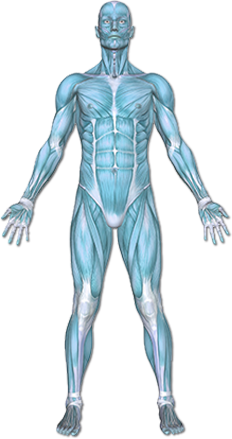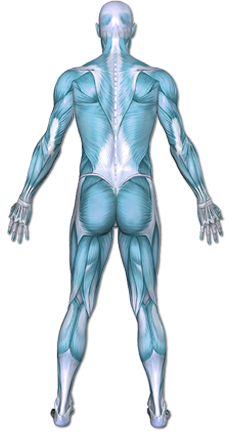Frozen Shoulder
Frozen shoulder is a tightening of the shoulder joint. It results in a loss of movement and pain at the shoulder joint. In frozen shoulder: • Active range of motion is lost—You cannot move your shoulder well. • Passive range of motion is lost—Someone trying to move your arm at the shoulder joint will find it stiff and difficult to move. This condition may get worse over time. After a period of time, the shoulder may also improve spontaneously. This improvement is called thawing.


Copyright © Nucleus Medical Media, Inc.
This content was created using EBSCO’s Health Library
Frozen shoulder is caused by tightening of the soft tissues. This includes the capsule that surrounds the joint. The cause of the tightening is usually not known.
This content was created using EBSCO’s Health Library
Factors that increase your risk for frozen shoulder include:
- Diabetes
- Thyroid problems
- Disc problems in your neck
- Injuries to the shoulder
- Illness or injury that forces you to keep the shoulder immobile for a period of time
- Heart and/or lung disease, during which time you do not move the shoulder normally
- Stress
This content was created using EBSCO’s Health Library
Symptoms include:
- Painful shoulder
- Significantly reduced movement of the arm at the shoulder joint, when moved by either yourself or by someone else
This content was created using EBSCO’s Health Library
The doctor will ask about your symptoms and medical history and perform a physical exam. The doctor will test the range of motion in your shoulder. Testing may include:
- X-rays
- MRI scan
- Arthrogram
This content was created using EBSCO’s Health Library
Treatment focuses on:
- Relieving pain
- Restoring function and range of motion to the shoulder
Nonsurgical Options
- Pain relievers (such as ibuprofen and aspirin)—to help reduce inflammation and relieve pain.
- Muscle relaxants—to help relax arm and shoulder muscles.
- Physical therapy—to stretch muscles and restore motion and function to the shoulder. This is the foundation of treatment. It requires home exercise.
- Heat and ice therapies—to help relieve pain and reduce swelling.
- Corticosteroid injections—as prescribed and given by your doctor (rarely done for this condition).
Surgery
Closed Manipulation
Closed manipulation surgery is a forceful movement of the arm at the shoulder joint. It is done to address the stiffness. The surgery is performed under anesthesia. The procedure is followed by intensive physical therapy. Be sure to follow your doctor’s instructions after surgery.
Arthroscopic Surgery
In arthroscopic surgery, a small incision is made in the shoulder. Special small instruments are inserted through the incision. The tightened tissues are released and the shoulder is manipulated. Physical therapy must be done after this procedure. Be sure to follow your doctor’s instructions after surgery.
Capsular Distension
Capsular distension is often done as a combination of an arthrogram and corticosteroid injection. The doctor expands the shoulder joint by injecting salt water under pressure. The fluid may contain cortisone and may also contain a dye that allows the shape and character of the shoulder joint to be seen on a CT Scan or MRI. If you are diagnosed with a frozen shoulder, follow your doctor’s instructions.
This content was created using EBSCO’s Health Library
To help prevent frozen shoulder:
- Do regular strength training and range-of-motion exercises. This will help maintain a strong and flexible shoulder joint.
- Seek prompt treatment for a shoulder injury.
- Do activities that use your shoulder joint regularly.
- After injury to an upper extremity (such as, hand, wrist, elbow), always move the shoulder through a full range of motion several times a day. This is true even when lying in bed for an illness such as a lung infection
This content was created using EBSCO’s Health Library
This content was created using EBSCO’s Health Library Resources
- American Academy of Orthopaedic Surgeons
- American Orthopaedic Society for Sports Medicine
CANADIAN RESOURCES:
- Canadian Orthopaedic Association
- Canadian Orthopaedic Foundation
REFERENCES:
- Adhesive capsulitis of shoulder. EBSCO DynaMed website. Available at: https://dynamed.ebscohost.com/about/about-us. Updated October 11, 2012. Accessed October 23, 2012.
- Ewald A. Adhesive capsulitis: a review. Am Fam Physician. 2011 Feb 15;83(4):417-422.
- Garcilazo C, Cavallasca JA, et al. Shoulder manifestations of diabetes mellitus. Curr Diabetes Rev. 2010 Sep;6(5):334-340.
- Neviaser AS, Hannafin JA. Adhesive capsulitis: a review of current treatment. Am J Sports Med. 2010 Nov;38(11):2346-2356.
- Woodward TW, Best TM. The painful shoulder part I: clinical evaluation. Am Fam Physician. 2000;61(10):3079-3088.
- Woodward TW, Best TM. The painful shoulder part II: acute and chronic disorders. Am Fam Physician. 2000;61(11):3291-3300.
This content was created using EBSCO’s Health Library


